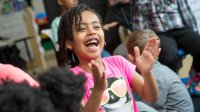Integrating Social and Emotional Learning in English Language Arts
Incorporating arts education into social and emotional learning can foster student growth in the elementary grades.
Your content has been saved!
Go to My Saved Content.Arts integration allows students to explore their knowledge, thoughts, opinions, and feelings about content in creative ways. Social and emotional learning (SEL) intentionally considers factors such as cooperation, empathy, communication, and active listening within an instructional setting. Therefore, promoting SEL through arts integration naturally fosters emotional growth, cooperative learning opportunities, and intuitive insights.
Integrating the arts and SEL can be overwhelming and exciting at the same time. I knew that my students would be engaged in this learning, but I didn’t know where to start without feeling like I would have to work twice as hard to create innovative lessons. The good news is you can seamlessly use arts integration and SEL in your classroom with ease.
In my classroom, I’ve used SEL and arts integration with “The Three Little Pigs.” Using this early elementary text, here’s how arts integration and SEL might look in your ELA lessons. I include suggested grade levels, but depending on the text you select, these activities can easily be adapted to other grades as well.
Drama and Cooperation
Creating a tableau and using cooperation, students in kindergarten and higher grades can perform the main idea of “The Three Little Pigs.” You can have students decide what part of the story are important to visually display in their tableau. Guide them to agree on what part each student is going to represent, and discuss how it’s going to look. The scene could be the pig building the big house or the wolf trying to blow down the house, for example. Encourage students to form the house themselves—they can build social skills by participating in a fun activity while collaborating with other students.
After student groups create and perform their tableaux, allow time for a classroom discussion on not only the tableaux but also what went well in the cooperative process.
Dance and Feelings
Using dance and movement in ELA helps tell the motivations, actions, and feelings of main characters in a story. An easy way to start integrating dance into your ELA lesson is to use locomotor and non-locomotor movement to tell parts of the story, such as a scene from “The Three Little Pigs.”
Ask students to use several locomotor and non-locomotor movements to create the house-building process for each pig. For example, students performing the pig building the straw house could use three locomotors, such as getting hay, jumping to the roof, and walking around the house, and three non-locomotor movements, such as bending down to pick up hay, reaching to put the hay up, and patting the hay down. With this activity, they will also have to use empathy to understand and perform actions from the perspective of the character.
In order to depict an accurate dance movement, they must understand the characters’ personality, actions, motives, and feelings. Therefore, this dance and feelings activity is best for grades 2 and up.
Music and Empathy
There is often poetry found in music. From the lyrics of a song to the tempo of the stanzas, one can find the synchronistic relationship they have with one another. For this lesson (appropriate for grades 3 and up), students should have prior knowledge of poetry writing and an understanding of how to write a simple poem.
Begin by giving students a prompt such as, “Which character makes you feel (insert feeling)?” Students will then elaborate within their poem by answering the who, what, and why of a character. Once they have written their poems, have them present the poems with awareness and tempo. Allow them to clap or snap as they read their poem to keep the tempo. Also, encourage them to change the tone of their poem to reflect the feelings (using a soft tone for sadness, for example, or a louder tone for anger or a cheerful tone for happiness).
Visual Arts and Perspective-Taking
Visual arts may be the easiest way to start using arts integration in the classroom. Ask students to view an image (a painting or photograph) with a person or character in it. Then ask them to write a first-person narrative about their life from the perspective of the person or character in the image. In their writing, they will consider what the person or character is feeling or thinking.
This activity, which is best suited for grades 3 and up, allows students to consider the perspective of someone else, especially if the image is used in addition to a previous story with the same character. A sample character sketch might look like this: “I am the Big Bad Wolf. I am always very hungry. Other animals are afraid of me because I try to eat them. It’s not my fault. I can’t help that I am hungry. I am a pretty confident guy, and I know that I am faster and smarter than most animals. Pigs are my favorite things to eat… so yummy and juicy. Plus, they never see me coming! It is great to be a wolf.”
Integrating SEL into the arts is impactful for students and considers the whole child during instruction. If nothing else, this combination encourages educators and students to try new ideas.
